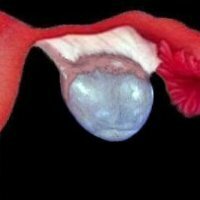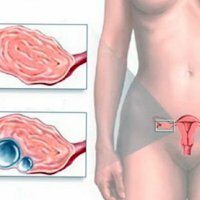Dysmenorrhea
 Dysmenorrhea is a pathological menstruation, the leading symptom of which is a pronounced pain syndrome accompanied by a wide range of neuro-metabolic, vegetative and endocrine disorders. According to numerous studies, the incidence of dysmenorrhea varies between 30% -90%.Such a statistical spread is evidently due to the fact that a group of women that were ambiguous in terms of age, health and social status were chosen for the study. The maximum prevalence of dysmenorrhea is observed among 20 to 24-year-old women. An important role in the research of dysmenorrhea is also played by the individual pain threshold. Patients with different perceptions of pain interpret their sensations in different ways, therefore it is not advisable to be guided only by complaints without taking into account the height of the pain threshold.
Dysmenorrhea is a pathological menstruation, the leading symptom of which is a pronounced pain syndrome accompanied by a wide range of neuro-metabolic, vegetative and endocrine disorders. According to numerous studies, the incidence of dysmenorrhea varies between 30% -90%.Such a statistical spread is evidently due to the fact that a group of women that were ambiguous in terms of age, health and social status were chosen for the study. The maximum prevalence of dysmenorrhea is observed among 20 to 24-year-old women. An important role in the research of dysmenorrhea is also played by the individual pain threshold. Patients with different perceptions of pain interpret their sensations in different ways, therefore it is not advisable to be guided only by complaints without taking into account the height of the pain threshold.
Painful menstruation is present both in complaints of the majority of patients with gynecological pathology, and in young, healthy women. Perhaps, menstrual pain can be called the most common symptom, but it is not always associated with serious pathological causes.
Dysmenorrhea should be distinguished from the usual moderately painful menstruation, which happens occasionally in almost every( 90%) woman. Since during the menstrual bleeding the musculature of the uterus is shrinking rapidly, unpleasant subjective sensations arise in women, which they define as "pulls", "noises", "aches a bit," and so on. Such feelings are not constant and do not tend to worsen, with physiological menstruation, such symptoms do not interfere with a woman to lead a normal life, do not aggravate her well-being and are not accompanied by other alarming symptoms.
The diagnosis of dysmenorrhea involves not only severe pelvic pain. More often they are accompanied by a headache and / or dizziness, nausea, dyspepsia and / or diarrhea, sleep disturbance, emotional disorders. It should be noted that the episode of pathological menstruation by the type of dysmenorrhea is not considered as a disease, if the subsequent monthly again become "normal".
According to the period of onset, dysmenorrhea is classified into primary and secondary. Dysmenorrhea in girls, as a rule, is primary and manifests with the first menstruation. Secondary dysmenorrhea appears after a period of normal menstrual function and is almost always associated with gynecological pathology( inflammation, fibroids, endometriosis, polyps and others).Dysmenorrhea in girls is especially common, often( 45%), it has severe forms, an average degree of severity is observed in 35%, and only 20% of young patients indicate an easy degree of ailment.
Find out the cause of dysmenorrhea is not always easy. The menstrual cycle is formed with the participation of the nervous, endocrine and reproductive systems, and the cause of its change may be hidden in any of them. The source of menstrual disorder can be detected only after a thorough examination. As a rule, the examination begins with the most simple diagnostic measures( interrogation, examination, laboratory diagnostics), but may require more in-depth examination( MRI, CT, hysteroscopy and others).
In the diagnostic search for dysmenorrhea, adjacent specialists - endocrinologists, neuropathologists and therapists often take part. Their help is needed in those often situations where the presence of dysmenorrhea is not accompanied by violations on the part of the genital area, that is, the disease has non-gynecological causes.
Dysmenorrhea is being treated not only as a disease. It is also a social problem, since it significantly affects the working capacity and quality of life of young women and can lead to a loss of health. Therefore, the question of the need for its treatment is always solved positively.
To relieve the patient of the painful monthly symptoms of dysmenorrhea, it is necessary to establish her exact cause. The treatment of primary dysmenorrhea is aimed at eliminating the pain syndrome and recreating the correct hormonal regulation of the menstrual cycle. Dysmenorrhea in adolescents also requires correction of neurovegetative and endocrine disorders. The treatment of secondary dysmenorrhea coincides with the therapy of the disease, which provoked it.
If the tactic of treating dysmenorrhea is chosen correctly, and therapy is started in a timely manner, the prognosis of the disease remains favorable.
Causes of dysmenorrhea
The menstrual cycle is a chain of successive physiological changes in the body, which are controlled by the central nervous system( the brain) - the pituitary gland and the hypothalamus. Hypothalamus synthesizes biological active substances, under their influence in the pituitary gland, rhythmic secretion of follicle-stimulating( FSH) and luteinizing( LH) hormones occurs in the phases of the cycle. They "control" all subsequent processes occurring in the ovaries.
In the first( follicular) phase of the cycle, the follicle-stimulating hormone of the pituitary gland actively interacts with the tissues of the ovaries and together with estrogens stimulates the growth and development of follicles - "bubbles" with a capsule filled with a clear liquid. The follicle serves as a place for the maturation of the egg, it protects it from unwanted external influences until it ripens completely, and then collapses( the period of ovulation) so that the adult germ cell can leave the ovary and become fertilized.
The ovulation period completes the first and begins the lutein( second) phase of the cycle. When the ovum leaves the ovary, a yellow body forms on the site of the destroyed follicle with the participation of the luteinizing hormone of the pituitary gland. It functions as a temporary hormonal gland, synthesizing progesterone. If fertilization does not happen, the egg dies, and the yellow body collapses shortly before the start of another menstruation.
The "point of application" for all changes in the ovaries is the uterus. According to the phase fluctuations in the level of hormones, the lining of the uterine cavity of the epithelium( endometrium) first grows and increases in volume( the first phase), and then begins to separate from the uterine wall( phase two) and is evacuated from the uterus during menstruation.
To get rid of the rejected endometrium and blood, the uterine wall performs rhythmic contractions, the strength of which is determined by the amount of accumulated contents in it. That is, the more blood and tissues in the uterus, the stronger it shrinks. This explains the unpleasant sensations in the projection of the uterus in the early days of menstrual bleeding.
How does the uterus know that it needs to shrink? When the size of the uterus increases due to accumulated menstrual blood, the nerve endings become irritated and "inform" the uterine musculature about the need to evacuate unnecessary uterine contents.
Prostaglandins play a large role in the mechanism of uterine contractions. These biological active substances are synthesized by the cells of the body and stimulate the musculature of the uterus. If for any reason the concentration of prostaglandins in the blood increases, the force of contraction of the uterine wall increases.
With dysmenorrhea, the mechanism of physiological uterine contractions is deformed. There is no clear idea of the mechanism of such a violation yet. The most reliable hypothesis of the emergence of dysmenorrhea is the excessive secretion of prostaglandins in connection with disturbances in the regulating chain "hypothalamus-pituitary-ovaries".
Primary dysmenorrhea in adolescents may be associated with congenital malformations of the genitals: partial or complete atresia( infection) of the cervical canal, abnormal position of the uterus and abnormalities of its development. In all other cases, the cause of dysmenorrhea is outside the genitals. Since more often primary dysmenorrhea has no organic causes, it is sometimes called functional or spasmodic.
In addition to mechanical, in primary dysmenorrhea there may be other causes, namely:
- Endocrine, associated with hormonal dysfunction and a violation of the synthesis of prostagalandins;
- Constitutional. These include pronounced sexual infantilism, when against the background of underdevelopment of uterine musculature, normal evacuation of menstrual blood is impossible.
- Psychoemotional. It is known that strong emotional experiences or depression can affect the work of important brain centers( pituitary gland, hypothalamus) and even change the pain threshold.
Primary dysmenorrhea is classified into:
- Essential. This variety of dysmenorrhea has no obvious cause, therefore it is sometimes considered a variant of the individual norm. It is also often explained by increased pain sensitivity.
- Psychogenic. Menstrual pains are associated with excessive psychoemotional lability or asthenic-vegetative syndrome. The sensation of anxiety and fear of pain before the menstrual period is more characteristic of girls or women with pronounced psychopathy who entered puberty.
- Spasmogenic, developing due to violation of the processes of contraction of the uterine wall.
Secondary dysmenorrhea is always associated with gynecological pathology. Its appearance is preceded by a period of normal menstrual function. Most often it provokes:
- genital endometriosis( external or internal);
- infectious and inflammatory sexual ailments( metroendometritis, salpingo-oophoritis);
- uterine myoma( especially submucous) and polyps of the uterus;
- adhesive process in the uterus or surrounding pelvic cavity and others.
Infrequently, the source of menstrual pain may be the intrauterine device.
Any dysmenorrhea requires examination and adequate therapy, if necessary.
Symptoms and signs of dysmenorrhea
The dysmenorrhea clinic always agrees with the causes of its appearance, but with any etiology of the disease, the expressed pain syndrome remains the leading one. Menstrual pain can be moderate and quite tolerable or so strong that a woman can not lead a habitual way of life, spends several days in bed taking large doses of analgesics. Pain in dysmenorrhea is always permanent, they accompany every menses, and their intensity sometimes increases from cycle to cycle. This symptom helps distinguish dysmenorrhea from single episodes of painful periods.
In addition to pain of varying intensity, dysmenorrhoea is often accompanied by other pathological symptoms. Since they are not associated with the genitals, they are called systemic. Usually such are headache( usually migraine), dizziness, nausea, vomiting, sleep disturbance, fever. Emotional disorders manifest themselves in the form of anxiety, tearfulness and various phobias.
Secondary dysmenorrhea is always accompanied by symptoms of the disease, which provoked it. Dysmenorrhea is able to progress. If the clinic of the disease remains unchanged for a long time, dysmenorrhea is considered compensated, and when the intensity of pain increases with each passing year, they speak of decompensated dysmenorrhea.
The intensity and duration of the pain syndrome is another important criterion for the diagnosis and therapy of dysmenorrhea, therefore it is common to distinguish several degrees of pain:
• Light, first, the degree of dysmenorrhea is characterized by mild pelvic pains without serious accompanying disorders. The general state of health practically does not suffer, reception of anesthetizing agents is not required. Light dysmenorrhea resembles a physiological menstruation, but unlike it has persistent symptoms that can grow with time. Often, such dysmenorrhea does not progress.
• The second degree of dysmenorrhea is classified as moderate. Pain accompanies every menses and requires the use of analgesics, because they do not allow the patient to lead a habitual way of life. Moderate dysmenorrhea, in addition to pain, is distinguished by the appearance of other, systemic, symptoms. With secondary dysmenorrhea, the clinic of the underlying disease joins. This degree of disease is distinguished by a good effect from taking anesthetic drugs.
• A bright clinic accompanies the third, most severe, degree of dysmenorrhea. Pelvic pains are expressed so strongly that they literally "put" the patient in bed, limiting her work capacity and any physical activity. Systemic symptoms are very pronounced. Severe dysmenorrhea does not respond to independent medication, taking analgesics does not bring relief.
Diagnosis of dysmenorrhea is the result of a lengthy diagnostic search, it includes:
- Primary Gynecological Reception. Detailed conversation allows you to find out the age, the nature of menstrual function and determine the time of the onset of painful periods and the presence of systemic symptoms. In the case of primary dysmenorrhea, a gynecological examination does not reveal abnormalities. If menstrual pains have a secondary origin, palpation of the uterus and appendages reveals the signs of the underlying disease.
- Laboratory diagnostics. Particularly relevant in the search for the causes of secondary dysmenorrhea. Includes a study on the presence of infection( smears and crops), as well as the definition of the hormonal profile( FSH, LH, estrogens, progesterone and others).
- Ultrasound scanning. Primary dysmenorrhea is formed without organic changes in the genitals, so this examination does not show the pathology, but in the case of secondary dysmenorrhea it is necessary for the diagnosis of fibroids, polyps and other pathologies. Also, ultrasound can diagnose some infectious and inflammatory processes of the pelvic region.
- MRI, CT.Costly studies, infrequently used for questionable results of ultrasound.
- Encephalography. Allows to exclude the pathology of the central nervous system in the presence of the patient complaints of severe headaches and migraines.
- Hysteroscopy. It is not often performed if there is a suspicion of intrauterine synechia or adenomyosis.
Sometimes to the diagnostic search involve related specialists - therapists, surgeons, endocrinologists, neuropathologists and others.
If a complete examination failed to identify the cause of menstrual pain, they resort to diagnostic laparoscopy.
Primary dysmenorrhea
Symptoms of primary dysmenorrhea appear in girls with the first menstruation( menarche) or for the next two years and are associated with the establishment of a regular ovulatory cycle. Menstrual pain occurs from the first day of menstruation or 12 hours before their onset.
Dysmenorrhea in adolescents is almost always accompanied by violations of the menstrual cycle. Most young patients suffer from symptoms of premenstrual syndrome. Every second has a neuropsychiatric, and every fifth has a cephalic or a crisis form.
Also, primary dysmenorrhea in girls is combined with systemic ailments: vegeto-vascular dystonia, bile duct dyskinesia, mitral valve prolapse, myopia, scoliosis, flatfoot. Waiting for another painful menstruation causes emotional discomfort, affects the overall well-being and disrupts the habitual life rhythm.
All systemic disorders accompanying primary dysmenorrhea can be conditionally divided into:
- Vegetative. Girls are concerned about headaches( migraines), fever with chills, increased sweating, weakness, palpitations and cardiac pain, dysfunction of the intestine and bladder. There may be vomiting, convulsions, changes in blood pressure( increase or decrease).Some patients on the eve of menses note an increase in body weight due to fluid retention in the tissues, marked swelling on the face and / or limbs. In severe dysmenorrhea, syncope occurs.
- Psychoemotional. Adhere to girls with asthenic physique and psychopathic personality type. During menstruation, such patients have a "lump in the throat", shortness of breath or attacks of suffocation. Girls become irritable and even aggressive, sleep badly, feel unmotivated anxiety, fear, apathy.
When examining girls with primary dysmenorrhea, skin changes are revealed: pallor;Vascular nets appearing through thin skin;Intradermal ruptures and strains( striae).There may also be violations of posture( kyphosis, lordosis, scoliosis), flat feet.
Since the cause of primary dysmenorrhea, in addition to the malformations of the genitals, is outside the genital area, it is necessary to find a disease that hides behind menstrual pains.
Secondary dysmenorrhea
Menstrual pain of a secondary nature is always associated with any gynecological ailment, therefore secondary dysmenorrhea is not an independent diagnosis but a symptom of the disease that caused it.
The most common cause of secondary dysmenorrhea is endometriosis - a complex hormone-dependent pathology. The essence of the disease is the pathological development of endometrial tissue outside its normal location. Endometriosis affects the ovaries, pelvic organs, peritoneum, in rare cases it is diagnosed far beyond the pelvic organs, for example, in the lungs or on the skin. With endometriosis of the uterus( adenomyosis) pathological foci are found in the thickness of the muscular wall. Getting into the "wrong places", the endometrium sites function according to their purpose, imitating normal menstruation: they grow, and then are rejected with the allocation of a small amount of blood.
In endometriosis, menstrual pains are often aching, radiating to the lumbar region, sacrum and / or rectum, they are very rare, less frequent, accompanied by nausea, vomiting, dizziness, fainting and / or imitating an attack of the "sharp abdomen".For endometriosis is characterized by the onset of pain for several days( 5-7) before the start of another menstruation, by the 2nd-3rd day of menstruation, they have the maximum intensity, and then gradually abate and pass definitively only to the middle of the cycle.
In addition to pain, endometriosis provokes more abundant periods, and the amount of menstrual blood loss increases over the years. Also, the disease is characterized by prolonged smearing brown secretions before and immediately after the end of menstruation.
Secondary dysmenorrhea is also a symptom of uterine fibroids. Especially often painful monthly provokes a submucous( submucous) myomatous node. The presence of fibroids in the uterine wall does not allow it to contract correctly during menstruation. In addition, when there is a large-sized myomatous node in the uterus, it perceives it as a foreign body and tries to tear it away with stronger cuts.
Inflammatory processes in the small pelvis also often provoke secondary dysmenorrhea. Against the background of pronounced inflammation in the pelvic cavity appears inflammatory exudate. Its initially liquid consistency changes over time - it becomes more viscous, dense, forms strands( adhesions) and "glues" nearby the tissues and pelvic organs, pulling them towards each other. Spikes restrict the normal mobility of the genital organs and prevent them from functioning correctly, provoking pelvic pain. A distinctive feature of the pain syndrome in the adhesive process in the pelvic region are constant aching pains that increase during menstruation, but do not pass after its termination.
There may be a lot of reasons for secondary dysmenorrhea, but it always combines with the clinic of another disease, because of which it appeared.
Treatment of dysmenorrhea
Because secondary dysmenorrhea is just one of the symptoms of a gynecological disease, it is not advisable to talk about her isolated treatment. Treatment of secondary dysmenorrhea is carried out in parallel with the treatment of the underlying disease. Conventional painkillers for dysmenorrhea of secondary genesis can cope well with menstrual pain, and all other means are directed at treating their causes.
As in the structure of gynecological incidence of adolescent girls primary dysmenorrhea takes a strong leading position, it is impossible to overestimate the significance of treatment of this pathology. According to data from various world sources, the incidence of adolescent dysmenorrhea varies from 5 to 90%.It should be noted that primary dysmenorrhea in most cases indicates serious disturbances in the functioning of the nervous, metabolic, endocrine and psychological spheres. So, almost 80% of girls have a painful attack with vomiting, 70% with diarrhea. One in five points to the presence of severe headaches and dizziness, which sometimes( 15%) provoke fainting.
Treatment of primary dysmenorrhea depends on the severity of the severity of the pain syndrome. Medications with dysmenorrhea first, mild, often not used, because menstrual pain is insignificant in strength. Usually, with mild dysmenorrhea without concomitant disturbance of the menstrual cycle, attention is drawn to the girl's lifestyle and her psycho-emotional status. Rid the patient of dysmenorrhea of the first degree is possible with the help of simple changes in lifestyle and nutrition. Also, long-term and continuous use of antioxidants( more often vitamin E) is possible to prevent vegetative and metabolic disorders.
Among the most popular causes of primary dysmenorrhea is a violation of the synthesis of prostaglandins. Therefore, the most commonly used medications for primary dysmenorrhea are non-steroidal anti-inflammatory drugs. They can suppress the excessive secretion of prostaglandins and relieve menstrual pain. More commonly used are Aspirin, Ibuprofen, Nimesulide, Naproxen and the like. These drugs are prescribed for the period of active menstrual pain according to the dosage indicated by the doctor. With severe pain, they can be used prophylactically three days before the start of the next month.
It is proved that many people with symptoms of primary dysmenorrhea have a magnesium deficiency in the body, in the body it participates in the transmission of nerve impulses and in contraction of smooth muscles( in particular, uterine muscles).Therefore, drugs are added to the therapy on the basis of magnesium salts: Magne-B6 and its analogues.
Before the initiation of primary dysmenorrhea therapy, the hormonal function of the patient is always examined. Often the primary dysmenorrhea in girls is combined with hormonal dysfunction in combination with a deficiency of the luteal phase. To adjust the menstrual cycle, determine the level of basic hormones.
If mild and moderate dysmenorrhea is accompanied by signs of luteal phase failure at a normal level of estrogen( estradiol), the second phase of the cycle is "strengthened" by gestagens( progesterone preparations).
Severe form of primary dysmenorrhea on the background of excessive secretion of estradiol is treated with monophasic hormonal drugs( Logest, Lindineth and the like).
In therapy for primary dysmenorrhea, non-drug methods of treatment should also be present: adequate nutrition, correct distribution of physical and mental stress, elimination of stressful situations, and others.
It is possible to use physiotherapy: electrophoresis, acupuncture, heat on the abdomen.
Unfortunately, even the most skilled therapy does not always cope with the symptoms of dysmenorrhea. Persistent, non-conservative treatment of severe dysmenorrhea, as well as dysmenorrhea on the background of malformations of the genitals require the conduct of laparoscopy.



